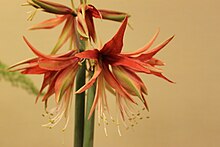Omphalissa
| Omphalissa | |
|---|---|
 |
|
| Hippeastrum cybister | |
| Scientific classification | |
| Kingdom: | Plantae |
| Clade: | Angiosperms |
| Clade: | Monocots |
| Order: | Asparagales |
| Family: | Amaryllidaceae |
| Subfamily: | Amaryllidoideae |
| Genus: | Hippeastrum |
| Subgenus: |
Omphalissa (Salisb.) Baker |
| Species | |
|
See article |
|
See article
Omphalissa is an unacceptedsubgenus of genus Hippeastrum, within the Amaryllidaceae family. Originally described by Richard Anthony Salisbury in 1866.
Robust habit, two to four large flowers. Perianth with a short tube(< 4 cm), paraperigonium curved closing the throat by a distinct neck. Stigma trifid or capitate, lobes > 2 mm. Spathe slit to the base. Ribbon-like leaves, 2.5 to 5 cm broad. Many dry, flat seeds.
Salisbury originally described the Omphalissa as a subgroup of the Zephyrantheae, then a tribe within the Amaryllidaceae, in which he included Amaryllis (now Hippeastrum) aulica and A. calyptrata. This was subsequently more formally defined by John Gilbert Baker in 1888, as a subgenus of Hippeastrum with six species. Baker's six species were;
Contains the epiphytic species of Hippeastrum.
...
Wikipedia
